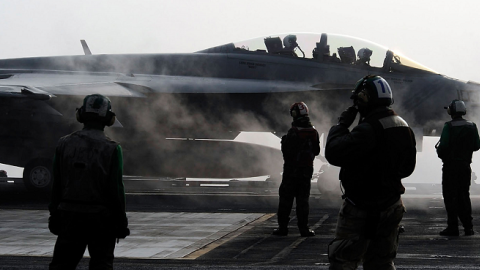The aircraft carrier followed quickly the invention of airplanes in the early 20th century. The U.S. deployed dozens of them to great effect in the Pacific during World War II. Then for the second half of the 20th century carriers’ utility has been subject to relentless questioning. Skeptics today ask whether the large size and cost of aircraft carriers combined with the threat posed to them by proliferating missiles are quietly closing the book on carrier aviation. Their skepticism is not just theoretical. A sullen cloud of uncertainty now hangs over the future of USS George Washington, a relatively new carrier that if refueled can remain useful for another 25 to 30 years. Congressional willingness to allow the U.S. carrier force to slip—even for two years—below the legal minimum of 11 carriers is daunting evidence that support for carriers as the U.S.’s chief instrument of naval power projection is yawing. So, the oft-raised question of these ships’ survivability is real. It deserves to be placed in the context of other weapons that advancing technology or tactics have replaced.
Cannon edged out the long bow in part because the former could reduce fortresses while the latter could not. Stone castles disappeared as defensive fortifications’ value against shot and powder crumbled. The superior defensive ability of metal over wood helped radically transform naval combatants. Naval aviation replaced battleships because airplanes could throw much more metal than their antecedents and could launch strikes at far greater distances than the old battle wagons. Occasionally, there are mistaken claims about new technologies’ ability to revolutionize: in the early 1980s the idea that synthetic aperture radars could make the seas transparent came and went. Submarines are still around. And so, thanks to technological advances in sensors, processors, and integration with weapons, are aircraft carriers whose obsolescence has been incorrectly foretold for decades. Transformative technologies only render an existing weapon vulnerable when effective countermeasures can no longer defend it.
Do proliferating missiles, especially China’s ballistic missile which is designed to strike a large-decked ship underway at sea, make aircraft carriers vulnerable beyond countermeasure? Does an aircraft carrier battle group possess the sensors and offensive capability to detect fast-approaching missiles and destroy them? The answer is yes. The air and missile defense radar (AMDR) that will be deployed as part of the Navy’s newly equipped Arleigh Burke-class destroyer is far more powerful than its predecessor, the SPY-1D which was introduced to the fleet three decades ago. Since then, processing ability and miniaturization have come a long way and along with them far greater sensitivity to targets. A U.S. naval captain who is responsible for sensors above the surface told IHS Jane’s International Defense Review this April that “AMDR will deliver 30 times the radar capability of SPY-1 yet still fit on a destroyer.” This will allow a ship’s combat information center to identify as a booster, decoy, or incoming warhead what had previously appeared as an indistinct fuzziness.
A carrier battle group’s defense against growing missile threats is not confined to AMDR. An evolved Sea Sparrow missile with increased range and killing power and better suited to defending against maneuvering supersonic anti-ship missiles and aircraft than its previous models will be mounted aboard the Ford-class carriers. The same projectiles will be deployed aboard the surface combatants that cast a redoubtable shield around aircraft carriers at large distances. Extensions in range, reductions in its visibility to enemy radars, and improved ability against electronic jamming will materially advance the Standard Missile which defends surface ships—like aircraft carriers and their escorts—at a distance four times that of the Sea Sparrow. The new upgraded Standard Missile will join the fleet this year. Other significant improvements in the layered shield that protects surface ships include a centralized command and control system specifically designed to be placed aboard carriers and amphibious ships to meet advancing threats from anti-ship cruise missiles. The list of improved sensors and significantly improved defenses goes on and in its robustness is powerful evidence of carriers’ and their escorts’ vigorous ability to adapt to new threats as they defend themselves successfully. The list includes enhanced jammers and spoofers that baffle an enemy missile’s ability to find its target.
However, this is not to say that changes in naval aviation are unneeded. Pilotless aircraft will eventually replace both today’s manned planes as well as the next generation of aircraft that is now being built. Drones flying off the decks of carriers offer the promise of significantly increased range, time over target, and stealth. They also decrease personnel costs, the size of a carrier’s crew, and the danger that now exists to a strike force whose pilots and navigators can be killed on training missions or captured and killed in combat.
Planes should be replaced because new technologies enlarge carriers’ striking ability as they reduce the crew’s exposure to harm. The aircraft carriers that launch planes should not be replaced because they can be protected by sensing systems like AMDR and increasingly lethal missile defenses. Wine, like airplanes, can be improved by agriculture, research, and the vintner’s technique. But the design of the bottles wine it is sold in has a more durable future. As should aircraft carriers.
















